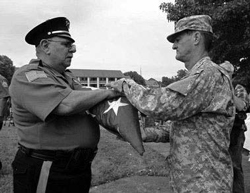In 1917, the first 32 soldiers arrived at what was then called Camp Little Silver, after the near-by town. Once a potato farm, the location was considered ideal because it was close to river and rail transportation. It was named Fort Monmouth in 1925 and soon be-came a breeding ground for many technological innovations, such as radio advances and language interpreters.
Over the years, the Fort’s research teams devised radar that could locate enemy artillery and mortars. The Fort created a field television camera with a backpack transmitter, and a pocket-sized radiation detector. It also developed or improved systems for surveillance and air traffic control as well as night-vision devices.
The Fort’s garrison flag was lowered, rolled up and covered for the final time last Tuesday. This week, the property will be turned over to a 14-member force that will maintain and secure it while another government commission seeks developers for its 1,100-plus acres.
After 94 years of helping soldiers communicate with each other while keeping tabs on the enemy, Fort Monmouth officially closed last Thursday. The military intelligence base was the victim of congressional budget cuts and relocation. Thousands of jobs have been transferred to the Aberdeen Proving Grounds in Maryland.
“It’s a huge waste of money. Politicians were involved, so what do you expect?” said Joe Jenkins, a resident of Eatontown, whose mother, father and brother all worked at Fort Monmouth.
“They’re spending all this money moving it to Maryland instead of keeping it here where people need it. It’s going to hit a lot of people and businesses hard.”
The Fort’s closure is affecting many people, in the state. Many residents have been emotionally affected, being so close to the Fort.
“It’s sad. It’s depressing. I just think it was all politics,” said Tom Hipper, a division chief who rode his motorcycle out the Fort’s main gate Thursday, for the last time.
“This was a great place to work,” said Hipper, whose duties included morale boosting and recreation for the troops, civilian workers and their families. “We all felt like we were doing something positive for our country, like we were an integral part of supporting the warriors.”
The base’s fate was sealed in 2005 when the Base Realignment and Closure Commission included Fort Monmouth in a list of military facilities it would close to save money. The commission estimated it would cost $782 million to move the Fort’s mission to Maryland, but the cost rose to nearly $2 billion by 2008, leaving a bitter taste in the mouths of many locals who depend on the base for jobs.
For University students, the closure of the Fort means one less internship location for government and engineering experience.
“I don’t think there’s anybody here who wants this place to go,” said Paul Sniffen, an electrical engineer at Fort Monmouth since 1984. “It’s unfortunate that this is going to be an out-of-state move.”
July 17, 2011 marked three days of celebrations, the last in Fort Monmouth’s 94-year history.
The Fort celebrated its involvement with the communities of Eatontown, Oceanport and Tinton Falls, while the public was invited to the base’s Greeley Field to observe tanks and experience some of the technological advances that serve the Army in the fields of communication, intelligence and surveillance.
Rep. Rush Holt (D-N.J.), who once appealed the BRAC decision, said it was a bittersweet weekend. “It’s worth celebrating the astounding accomplishments over the past century, from the days of carrier pigeons to Earth-observing satellites to some of the most sophisticated intelligence and electronics,” Holt said. “But to me, it underscores the bad decision the Army has made. It should have never made that decision.”
The economic situation in the surrounding area will no doubt suffer from this closure. Gerald Tarantolo is mayor of Eatontown, one of three communities upon which the base sits. He said his borough is already seeing more vacancies in commercial properties, which hurts the tax base.
Thousands of jobs from the Fort are being lost immediately. Of the 5,570 civilian and military jobs at the fort, 5,400 were to be transferred to Maryland. There were 3,144 civilian employees who took the Army up on its offer to move, Kearney said.
PHOTO COURTESY of Noah K. Murray

